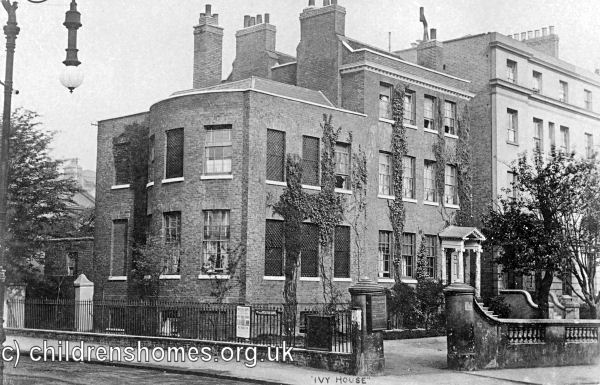Salvation Army Maternity Hospital, Mare Street, Hackney, London
In 1894, as part of its efforts to help the plight of 'fallen' girls and women, the Salvation Army opened a Maternity Hospital at Ivy House, 271 Mare Street, Hackney. The property had previously been used as a refuge and maternity home. For most of those using Ivy House, the only alternative would have been the workhouse, since other most maternity hospitals would only admit married women.
The establishment was normally restricted to girls and women having their first baby, although second cases were admitted in exceptional circumstances. A charge of between 10s. 6d. and 21s. per week was made.

Salvation Army Maternity Hospital, Mare Street, Hackney, early 1900s. © Peter Higginbotham
A report in 1906 recorded that the basement of the building contained a kitchen, dining room and bathroom for the domestic staff. On the ground floor were a dining room for midwife pupils and for nursing staff, also used for lectures, together with offices and a convalescent ward. The first floor housed four lying-in wards, a day nursery, and the Matron's bed-sitting room. The toilet, also used as a slop sink, was on the half landing below this floor. Hot and cold water sinks, used only for soapy water, were fitted in the first floor passage and second floor landing. On the second floor were the labour room, night nursery, a further lying-in ward and an ante-natal room, also used as a receiving room. The six wards provided a total of 22 beds plus 12 cots. The building was lit throughout by gas. There was no bathroom for the inmates, who made use of moveable baths in the ante-natal room and in the lying-in wards.
As the facilities at Ivy House began to prove increasingly inadequate, plans were made for a larger replacement facility. This was opened in 1913 at 153-156 Lower Clapton Road, Hackney. Ivy House was then closed and the building demolished.
Records
Note: many repositories impose a closure period of up to 100 years for records identifying individuals. Before travelling a long distance, always check that the records you want to consult will be available.
- The Salvation Army International Heritage Centre, William Booth College, Denmark Hill, London SE5 8BQ. Email heritage@salvationarmy.org.uk. Has a research service, with initial enquiries answered free, more detailed follow-up research charged at £20 per hour. There is also an online catalogue of the Centre's holdings.
Bibliography
- Booth, William In Darkest England, and the Way Out (1890, London: International Headquarters of the Salvation Army)
- Sandall, Robert The History of the Salvation Army (1955, London: Nelson)
- Bartley, Paula Prostitution: Prevention and Reform in England, 1860-1914 (2000, Routledge)
- Finnegan, Frances Poverty and Prostitution: A Study of Victorian Prostitutes in York (1979, CUP)
- Hopkins, Jane Ellice, Work Among the Lost (1870, William Macintosh) Nokes, Harriet Twenty-Three Years in a House of Mercy (1886, Rivingtons)
- Taylor, William J The Story of the Homes (1907, London Female Preventive and Reformatory Institution)
- Thomas, E W Twenty-Five Years' Labour Among the Friendless and Fallen (1897, Shaw)
Links
- The Salvation Army (UK)
- The Salvation Army — an illustrated history by Peter Higginbotham.
Except where indicated, this page () © Peter Higginbotham. Contents may not be reproduced without permission.


